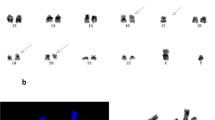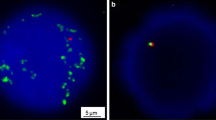Abstract
Childhood acute lymphoblastic leukemia (ALL) is the most common type of childhood leukemia. Specifically, ALL is a malignant disorder of the lymphoid progenitor cells, with a peak incidence among children aged 2–5 years. The t(12;21)(p13;q22) translocation occurs in 25 % of childhood B cell precursor ALL. In this study, bone marrow samples were obtained from 165 patients with childhood ALL. We analyzed the t(12;21) translocation and other related abnormalities using the fluorescent in situ hybridization (FISH) technique with the ETV6(TEL)/RUNX1(AML1) ES dual color translocation probe. Conventional cytogenetic analyses were also performed. ETV6 and RUNX1 related chromosomal abnormalities were found in 42 (25.5 %) of the 165 patients with childhood ALL. Among these 42 patients, structural changes were detected in 33 (78.6 %) and numerical abnormalities in 9 (21.4 %). The frequency of FISH abnormalities in pediatric ALL cases were as follows: 8.5 % for t(12;21)(p13;q22) ETV6/RUNX1 fusion, 6.0 % for RUNX1 amplification, 3.0 % for tetrasomy/trisomy 21, 1.8 % for ETV6 deletion, 1.21 % for ETV6 deletion with RUNX1 amplification, 1.21 % for ETV6 amplification with RUNX1 amplification, 0.6 % for polyploidy, 0.6 % for RUNX1 deletion, and 0.6 % for diminished ETV6 signal. The most common structural abnormality was the t(12;21) translocation, followed by RUNX1 amplification and ETV6 deletion, while the most commonly observed numerical abnormality was trisomy 21.
Similar content being viewed by others
References
Kebriaei P, Anastasi J, Larson RA (2002) Acute lymphoblastic leukaemia: diagnosis and classification. Best Pract Res Clin Haematol 15(4):597–621
Greenlee RT, Murray T, Bolden S, Wingo PA (2000) Cancer Statistics, 2000. CA Cancer J Clin 50:7–33
McNally RJ, Rowland D, Roman E, Cartwright RA (1997) Age and Sex distribution of Hematological Malignancies in the UK. Hematol Oncol 15:173–189
Ma SK, Wan TS, Chan LC (1999) Cytogenetics and molecular genetics of childhood leukemia. Hematol Oncol 17:91–105
Woo HY, Kim DW, Park H, Seong KW, Koo HH, Kim SH (2005) Molecular Cytogenetic Analysis of Gene Rearrangements in Childhood Acute Lymphoblastic Leukemia. J Korean Med Sci 20(1):36–41
Romana SP, Le Coniat M, Berger R (1994) t(12;21):a new recurrent translocation in acute lymphoblastic leukemia. Genes Chromosom Cancer 9:186–191
Romana SP, Mauchauffe M, Le Coniat M, Chumakov I, Le Paslier D, Berger R, Bernard OA (1995) The t(12;21) of acute lymphoblastic leukemia results in a tel-AML1 gene fusion. Blood 85:3662–3670
Shurtleff SA, Buijs A, Behm FG, Rubnitz JE, Raimondi SC, Hancock ML, Chan GC-F, Pui C-H, Grosveld G (1995) TEL-AML1 fusion resulting from a cryptic t(12;21) is the most common genetic lesion in pediatric ALL and defines a subgroup of patients with an excellent prognosis. Leukemia 9:1985–1989
Harrison CJ (2001) The detection and significance of chromosomal abnormalities in childhood acute lymphoblastic leukemia. Blood Rev 15:49–59
O’Connor HE, Butler TA, Clark R et al (1998) Abnormalities of the ETV6 gene occur in the majority of patients with aberrations of the short arm of chromosome 12: a combined PCR and Southern blotting analysis. Leukemia 12(7):1099–1106
Raynaud S, Cave H, Baens M, Bastard C, Cacheux V, Grosgeorge J et al (1996) The 12; 21 translocation involving TEL and deletion of the other TEL allele: two frequently associated alterations found in childhood acute lymphoblastic leukemia. Blood 87:2891–2899
Romana SP, Le Coniat M, Poirel H, Marynen P, Bernard O, Berger R (1996) Deletion of the short arm of chromosome 12 is a secondary event in acute lymphoblastic leukemia with t(12;21). Leukemia 10:167–170
Kobayashi H, Satake N, Kaneko Y (1997) Detection of the Der(21)t(12; 21) chromosome forming the TEL-AML1 fusion gene in childhood acute lymphoblastic leukemia. Leukemia Lymphoma 28:43–50
Loncarevic IF, Roitzheim B, Ritterbach J, Viehmann S, Borkhardt A, Lampert F et al (1999) Trisomy 21 is a recurrent secondary aberration in childhood acute lymphoblastic leukemia with TEL/AML1 gene fusion. Genes Chromosom Cancer 24:272–277
Kempski H, Chalker J, Chessells J, Sturt N, Brickell P, Webb J et al (1999) An investigation of the t(12;21) rearrangement in children with B precursor acute lymphoblastic leukaemia using cytogenetic and molecular methods. Br J Haematol 105:684–689
Van Dongen JJ, Macintyre EA, Gabert JA et al (1999) Standardized RT-PCR analysis of fusion gene transcript from chromosome aberrations in acute leukemia for detection of minimal residual disease. Leukemia 13:1901–1928
Inamdar N, Kumar SA, Banavali SD, Advani S, Magrath I, Bhatia K (1998) Comparative incidence of the rearrangements of TEL/AML1 and ALL1 genes in pediatric precursor B acute lymphoblastic leukemias in India. Int J Oncol 13:1319–1322
Forestier E, Andersen MK, Autio K et al (2007) Cytogenetic patterns in ETV6/RUNX1- positive pediatric B-cell precursor acute lymphoblastic leukemia: a Nordic series of 245 cases and review of the literature. Genes Chromosom Cancer 46:440–450
Liang DC, Chou TB, Chen JS, Shurtleff SA, Rubnitz JE, Downing JR et al (1996) High incidence of TEL/AML1 fusion resulting from a cryptic t(12;21) in childhood B-lineage acute lymphoblastic leukemia in Taiwan. Leukemia 10:991–993
Tsang KS, Li CK, Chik KW, Shing MM, Tsoi WC, Ng MH et al (2001) TEL/AML1 rearrangement and the prognostic significance in childhood acute lymphoblastic leukemia in Hong Kong. Am J Hematol 68:91–98
Veiga LBA, Coser VM, Cavalli LR et al (2004) High frequency of t(12;21)(p13;q22) in children with acute lymphoblastic leukaemia and known clinical outcome in southern Brazil. Leuk Res 28:1033–1038
Harrison CJ, Moorman AV, Barber KE et al (2005) Interphase molecular cytogenetic screening for chromosomal abnormalities of prognostic significance in childhood acute lymphoblastic leukaemia: a UK Cancer Cytogenetics Group Study. Br J Haematol 129:520–530
Borkhardt A, Cazzaniga G, Viehmann S et al (1997) Incidence and clinical relevance of TEL/AML1 fusion genes in children with acute lymphoblastic leukaemia enrolled in the German and Italian multicenter therapy trials. Blood 90:571–572
Chung HY, Kim KH, Jun KR, Jang S, Park CJ, Chi HS, Im HJ, Seo JJ, Seo EJ (2010) Prognostic significance of TEL/AML1 rearrangement and its additional genetic changes in korean childhood precursor b-acute lymphoblastic leukemia. Korean J Lab Med 30:1–8
Ko DH, Jeon Y, Kang HJ, Park KD, Shin HY, Kim HK, Cho HI, Ahn HS, Lee DS (2011) Native ETV6 deletions accompanied by ETV6-RUNX1 rearrangements are associated with a favourable prognosis in childhood acute lymphoblastic leukaemia: a candidate for prognostic marker. Br J Haematol 155(4):530–533
Attarbaschi A, Mann G, Konig M, Dworzak MN, Trebo MM, Muhlegger N, Gadner H, Haas OA (2004) Incidence and relevance of secondary chromosome abnormalities in childhood TEL/AML1 + acute lymphoblastic leukemia: an interphase FISH analysis. Leukemia 18:1611–1616
Park KU, She CJ, Shin HY, Ahn HS, Kim CJ, Cho BK, Cho HI, Lee DS (2001) The low incidences of TEL/AML1 fusion and TEL deletion in korean childhood acute leukemia by extra-signal fluorescence in situ hybridization. Cancer Genet Cytogenet 126:73–77
Lee DS, Kim YR, Cho HK, Lee CK, Lee JH, Cho HI (2005) The presence of TEL/AML1 rearrangement and cryptic deletion of the TEL gene in adult acute lymphoblastic leukemia (ALL). Cancer Genet Cytogenet 162:176–178
Gmidene A, Senana H, Elghezal H et al (2008) Cytogenetic analysis of 298 newly diagnosed cases of acute lymphoblastic leukemia in Tunisia. Hematol Oncol 26(2):91–97
Izraeli S, Vora A, Zwaan CM, Whitlock J (2014) How I treat ALL in Down’s syndrome: pathobiology and management. Blood 123(1):35–40
Acknowledgments
This study was supported by the Akdeniz University Scientific Research Management Foundation.
Conflict of interest
The authors declare that they have no conflict of interest.
Author information
Authors and Affiliations
Corresponding author
Rights and permissions
About this article
Cite this article
Aydin, C., Cetin, Z., Manguoglu, A.E. et al. Evaluation of ETV6/RUNX1 Fusion and Additional Abnormalities Involving ETV6 and/or RUNX1 Genes Using FISH Technique in Patients with Childhood Acute Lymphoblastic Leukemia. Indian J Hematol Blood Transfus 32, 154–161 (2016). https://doi.org/10.1007/s12288-015-0557-7
Received:
Accepted:
Published:
Issue Date:
DOI: https://doi.org/10.1007/s12288-015-0557-7




